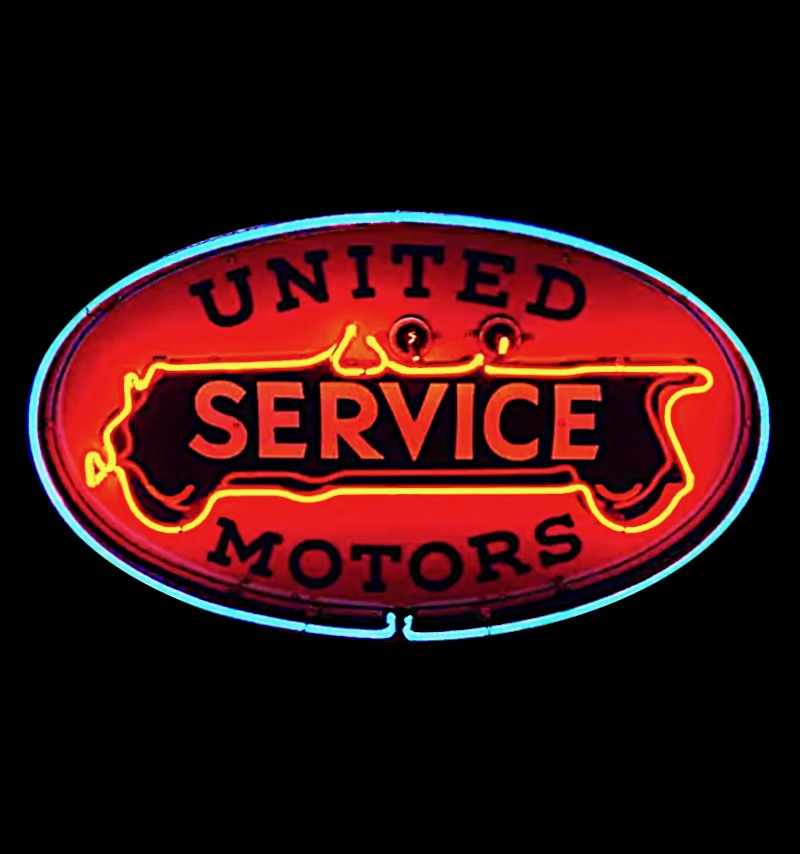

Title: United Service Motors Antique Automotive Neon Advertising Sign
Shipping: $29.00
Artist: N/A
Period: 20th Century
History: Art
Origin: North America > United States
Condition: N/A
Item Date: N/A
Item ID: 564
Consignment / Call for availability and price. Absolutely beautiful antique automotive neon advertising sign from United Service Motors. These vintage signs are highly desirable, rare, and hard to find. The marketing of antique motor garage decorative signs has its roots in the early to mid-20th century, coinciding with the rise of automobiles and the establishment of motor garages and service stations. These signs served both practical and promotional purposes, reflecting the aesthetics of the time and the unique identity of each business. In the early days of the automotive industry, as cars became more accessible to the public, the need for repair and maintenance services grew. Motor garages and service stations began to pop up, creating a competitive market. To stand out and attract customers, businesses started using signage as a form of advertising. The designs of these signs were often influenced by the Art Deco and Art Nouveau movements, reflecting the contemporary styles of the era. Bold colors, streamlined shapes, and stylized lettering were common features. The goal was not only to indicate the presence of a garage but also to create a visually appealing and memorable brand image. Neon signs, with their vibrant glow and eye-catching allure, became particularly popular in the marketing of motor garages. These signs not only served a functional purpose by enhancing visibility, especially during nighttime hours, but they also added a touch of glamour and modernity to the businesses. As the automotive culture evolved, so did the design of garage signs. Brands and businesses began to incorporate specific symbols and logos that became instantly recognizable to motorists. These signs became a symbol of trust, quality service, and reliability. The heyday of these decorative signs was during the mid-20th century, but as technology advanced and marketing strategies shifted, the prominence of these signs diminished. Many were replaced by more modern forms of advertising. However, the nostalgia for vintage aesthetics and the appreciation for craftsmanship have led to a resurgence in interest for antique motor garage signs among collectors and enthusiasts. Today, these signs are not only valued for their historical significance but also as unique pieces of art that capture the spirit of a bygone era in the automotive industry. Collectors seek out these signs to preserve and showcase a piece of the rich history of motor garages and the marketing strategies that defined an era.
Antique neon signs have a fascinating history that illuminates the evolution of advertising and visual communication. The use of neon gas for illumination was discovered in the late 19th century, but it wasn't until the early 20th century that it found its way into the world of signage. The first commercial use of neon signs dates back to the 1920s, with Paris and London being among the first cities to showcase these vibrant creations. However, it was in the United States, particularly in Los Angeles and New York, where neon signs truly became an iconic part of the urban landscape. Neon signs gained immense popularity during the Art Deco movement of the 1920s and 1930s. The unique ability of neon to produce a wide spectrum of colors captivated business owners and artists alike. This marked the beginning of neon signs becoming synonymous with nightlife, theaters, and entertainment districts. In the following decades, neon signs became an integral part of the American roadside experience. They adorned motels, diners, and gas stations, creating a distinctive and nostalgic aesthetic that still resonates today. Each sign was a work of art, crafted by skilled artisans who bent and shaped glass tubes to bring intricate designs to life. However, the heyday of neon signs began to dim in the 1960s and 1970s with the advent of cheaper and more energy-efficient alternatives like LED signage. Many neon signs were taken down and replaced, making the surviving antique neon signs cherished relics of a bygone era. Today, collectors and enthusiasts celebrate the history of antique neon signs, recognizing them not only as functional pieces of advertising but also as iconic symbols of a vibrant and dynamic cultural past. The craftsmanship and artistry involved in creating these signs continue to be appreciated, ensuring that the legacy of antique neon signs continues to shine brightly.